If anyone is interested as well, my "Basic Bee" xover design submission. It was intended to be as simple as possible for the given drivers, with emphasis on in-room response curve over on-axis response.
As designed, assuming zero delay for the woofer, only -145mm y axis offset included for use of polar data.
If I include the required 20mm of delay to the woofer, it creates a bit more of a 3-4kHz dip than I has wanted.
Overlay comparison on-axis. Blue is without delay, white is with delay included.
Is it me ? but it looks like you ended up with steeper roll-offs than what I'd guess for a 2nd / 3rd order filter Xover combo. And/or you hit the Xover point just about right for these drivers.
If you don't mind, for my learning info, going from an initial run of component values (out of the software box) could you walk me though your thought process and which components did you adjust, and effects.
My take on the crossover deal now knowing a bit about it was mirrored by what Ben just mentioned. I was pretty much focused on the opera singer track as the main influence on judgment. When I initially heard #2 I was intrigued and voted for it. Then as the next few played I kinda questioned what I noticed in that track till #7 played. It also struck me as special, with #9 kinda there too. Overall I picked 2 after hearing the top three played. If what you said about #2s response is true, this mimicks how I normally voice my speakers, which is BBC dip and a bit brighter up top.
That being said, that was a fun experiment, but needed a few changes to make things flow better. Me personally, fewer tracks with fuller compositions and mandatory connections and labeling. I think an A or B bracket would have been easier to discern differences and you guys could have just stood there to swap xovers having a shorter test track.
Otherwise I still thought it was fun. A lot of them sounded fine, but goes to show small idiosyncrasies can make a difference. Thanks for putting that together guys!
Yes, it was very fun and I do feel I learned a lot. At the very least it was a good exercise.
I was concerned that mine would appear "amateur" in comparison to many of the other very talented designers. I think it faired well and what I heard from the back of the room seemed to match my expectations. Matt Sobie did help a bit, in the end what we came up with after our phone conversation matched values and topologies I had already siimulated, just different configuration.
A lot of the designs that I thought sounded good had some form of BBC dip. If everyone shared simulations I might try a few and see what sounds best in my room.
I was surprised to hear a few people picked their own designs. Curious if they had something that was an audible signature? This seems to prove that there is no "perfect" crossover, just a preference of compromises.
Is it me ? but it looks like you ended up with steeper roll-offs than what I'd guess for a 2nd / 3rd order filter Xover combo. And/or you hit the Xover point just about right for these drivers.
Filter order of passive filters doesn't often align perfectly with textbook slope, unless the load is purely resistive and the component selection is for a textbook response, which it isn't for most speakers.
With that in mind, if you look at the tweeter filter, I have -34dB at 1kHz, and -15.8dB at 2kHz making for 18.2dB/oct slope, aligns well with a 3rd order filter. However, the overall filter shape and knee is quite far from a textbook filter. Acoustic response aligns with a 4th order slope.
Looking at the woofer filter, I have -10.5dB at 2500Hz, and -24.5dB at 5000Hz making for 14dB/oct slope, relatively close to 12dB textbook target. Again, the overall filter shape and knee is miles from a textbook filter. Acoustic response aligns with a 4th order slope but only at high frequency as the shelf in the response throws it for a loop.
If you don't mind, for my learning info, going from an initial run of component values (out of the software box) could you walk me though your thought process and which components did you adjust, and effects.
It's like I mentioned above, I aimed for as simple as possible design that I would say is "good enough", with focus on overall in-room response. A true in-room and power response would require full 360 degree of response data, but we'll glance over that.
The biggest hurdle I had in achieving this goal is the 5dB shelf in the woofer response which in my opinion sort of forces your hand on crossover point for a low complexity design. Any attempt to notch the woofer breakup I found was detrimental to overall in-room / power response, and any change in crossover frequency made for a rather wonky response, so I just aimed for overall balance keeping it as simple as possible. You can see it mirrored through all the charts above, the directivity mismatch between these drivers, so in order to achieve a constant slope for in-room response, the on-axis response of the woofer is raised a bit 500-1500Hz, and the tweeter response has a bit of a trough from 2-4kHz.
@kenrhodes said:
A lot of the designs that I thought sounded good had some form of BBC dip. If everyone shared simulations I might try a few and see what sounds best in my room.
Well, simulations aside - prior to the start of the theme, I predicted that a design using less baffle step would win. EQ's design utilized less than 3db so it was somewhat louder than the rest, and with his inclusion of a dip right in the area where his 4th LR crossover was blooming off-axis to counter excess energy in the horizontal I would have been surprised if it hadn't won.
That being said, all designs presented fairly similar from my position in the back of the room. The biggest differences were largely in the Cecelia Bartolie track and the John Prine track, and of course the low bass in the metal track at the end was pretty much all lost. At our listening level, the little woofers were probably just a few db from running the risk of jumping the gap. They were borderline compressing mechanically as it was.
Bartolie and Prine were both fairly revealing of the woofer breakup and higher crossover points, as well as the tweeter impedance peak.
Some of the depth of the first track was likely lost on those not seated dead-center. Otherwise, it is a fun track to try and pick out the various passages.
The McLaughlin and Prine tracks were both prone to being sibilant heavy.
The string quartet was a Mozart piece, and it was included because we needed strings. I thought this was a good, clean example of just such a thing. Similar to the three guitar track it is fun to try and pick out the moment when the striking tool hits the string. The pick and the bow, as it were. (That would be a cool name for a bar).
Larry Coryell & Badi Assad & John Abercrombie - Seu Jorge E Dona Ica - Three Guitars
Mozart - String Quartet No. 17 in B-flat major, K. 458, "Hunt": Minuetto - The Very Best of Mozart (I do not know the conductor or specific quartet who performed it)
John Prine - Day is Done - Lost Dogs and Mixed Blessings (buy this album)
All six tracks were chosen to be a blend of the typical stuff we hear at these things as well as a few things we often forget are also a straight-up challenge to even the best speakers. The Powertrip track in particular really shines on a speaker that plays very deep and is capable of holding things together at the same time. 2-ways generally fare pretty poorly well-recorded metal at most listening levels and are pretty much inadequate if you want to tickle the neighbors fancy. John Prine is deceptively hard to render correctly as well, despite being little more than a middle aged man and his guitar.
Anyways, the missus and I had a great time even if I have spent most of the weekend feeling pretty green. No idea what got into me, but hopefully I feel back to normal pretty soon.
Ben, thanks for another fun time and theme challenge. I have hope since the top 2 of 3 were voiced. I think if the room was more neutral we could have heard more distinctions. The opera track was awesome along with the bass track at the end. I don't think we can ever have another DIY event without an opera track.
I'm not sure where the time went. We didn't have that many speakers and quite a few did not get to play on Saturday.
My apologies to Bill S for not making the tents this year.
We usually get a heads up on the theme for next year so we can buy drivers and MWAF, so ???
John-
I haven't even thought hard about it, but have ideas. I usually announce it by the MWAF event.
For those that wanted to see mine:
The LC was added after the FR sim, and the impedance was inaccurate as I removed the input compensation so I removed that portion of the image. The tweeter response should be close except around Fs.
Once I get the images on disc from Bill, I will upload network photos.
Ken-
The connections were SUPPOSED to be standardized. It was listed on the event website, and discussed at length in both MAC and PE forums. Jacks and leads on the same end of the board. I'm glad I had the foam in place or some of them would have been viewable being out of the bag for the demo. A couple had inputs on the opposing end. One had inputs on the opposing face from the components. One came loose from the input jack. One had crossed wires that needed spread out to fix a problem. Several had no markings to which was tweeter and which was woofer; I'm glad Nick and I know typical filter design or we would not have been able to get that connected right- and even still I had one flipped over the course of the demo. Simply- there was no complete consensus and acceptance of the layout as about half were not following it. Don't get me wrong, as I'm not complaining. We got through it just fine. It was just more difficult than it had to be.
EQ tried to get banana plugs/jacks shipped to him, but the process failed. That was the one I could not quickly resolve for connection, but only he/Nick/myself knew that was his set of boards due to the collars being tightened on the posts.
I used a notch filter at 900 hertz to attenuate a peak, possibly from enclosure diffraction. I went 2-3 decibels extra to make sure it was gone.
I used a 500 uF high pass on the woofer in an attempt to reduce low frequency excursion and hopefully improve the midrange with reduced Doppler distortion.
The tweeter had a single cap for both high pass and attenuation. The top end of the woofer was unfiltered.
Here is the electrical transfer function.
Here is the simulated frequency response, power response, and impedance. Notice how smooth the power response looks!
I couldn't detect which was mine during the theme event. Later, when everyone was packing up to leave, I gave it a listen. It sounded good overall but a bit flat and unexciting, most likely caused by the high crossover frequency. I was hoping for uninterrupted phase response in the midrange, I'm not sure that was a good decision. This is how we learn though.
@kenrhodes said:
A lot of the designs that I thought sounded good had some form of BBC dip. If everyone shared simulations I might try a few and see what sounds best in my room.
Here's my design Ken.!
Looks like the tweeter played to the dip nicely. I can see how that could work for a OE trying to sell speakers. Where I was in the back they did sound smooth and laid back. I did not perceive the high end rise, this could have been my location as well.
Congrats to E.Q. from Singapore, winner of the missing link xover design competition (entry #2). He completed his xover in the adjoining room just moments before the competition began. Special mention goes to Meredith C., as some of the parts from his 4 way OB speaker project were used by E.Q. to complete the winning xovers.
Thanks @kenrhodes for putting my crossover together and delivering to the event. It was nice to be able to be a part of one of these things even from 2000 miles away.
@6thplanet said:
I totally missed the award, when did that happen?
It was after the xover competition had ended and after we got back from lunch. So you must have had a long lunch. According to the time stamps on my photos, it occured from 1:26pm to 1:27pm CT (2:26 to 2:27pm ET).
John, What was the bag number on your xover? I am entering all the xovers into VituixCad's variant buttons so that I can quickly compare 8 crossover simulations against my listening notes. My xover was bag #4. Here is my VituixCad 6 pack screen:
@kenrhodes said:
A lot of the designs that I thought sounded good had some form of BBC dip. If everyone shared simulations I might try a few and see what sounds best in my room.
Here's my design Ken.!
Looks like the tweeter played to the dip nicely. I can see how that could work for a OE trying to sell speakers. Where I was in the back they did sound smooth and laid back. I did not perceive the high end rise, this could have been my location as well.
Thanks for sharing.
When I was talking to John afterwards, he said that some of the entries sounded dull from his seat, while in the back I didn't find any dull, and actually found a fair number too forward. While walking forward to change the entries I could hear that some of the designs had off axis issues around the crossover frequency. I also noticed that the woofer breakup was not controlled on all of the entries.
If you want to experiment/learn I would suggest that you try them all, so that you can correlate the sound to measured response in a familiar room and system, but if I was going to design a similar system from scratch, I would use the Dynavox poly cone woofer. In my opinion, it's a better, smoother, easier to use driver.
@kenrhodes said:
A lot of the designs that I thought sounded good had some form of BBC dip. If everyone shared simulations I might try a few and see what sounds best in my room.
Here's my design Ken.
Nick, What was the bag number for your xover? I am inputing all xovers as variants into my VituixCad model so that I can compare all xovers to my listening notes.
Bill, I know you said you were doing that for your notes but will you post a summary here? Either the VituixCAD 6 pack for each and/or overlays of the SPL curves?
@a4eaudio said:
Bill, I know you said you were doing that for your notes but will you post a summary here? Either the VituixCAD 6 pack for each and/or overlays of the SPL curves?
With Ben's permission, I could definitely do that. I don't know what Ben's plan is regarding posting the schematics or bag numbers. So far, I only have schematics for 6 of the 11 bag numbers. Still need schematics for bags 2, 8, 9, 10, and 11.
Comments
If anyone is interested as well, my "Basic Bee" xover design submission. It was intended to be as simple as possible for the given drivers, with emphasis on in-room response curve over on-axis response.
As designed, assuming zero delay for the woofer, only -145mm y axis offset included for use of polar data.
If I include the required 20mm of delay to the woofer, it creates a bit more of a 3-4kHz dip than I has wanted.
Overlay comparison on-axis. Blue is without delay, white is with delay included.
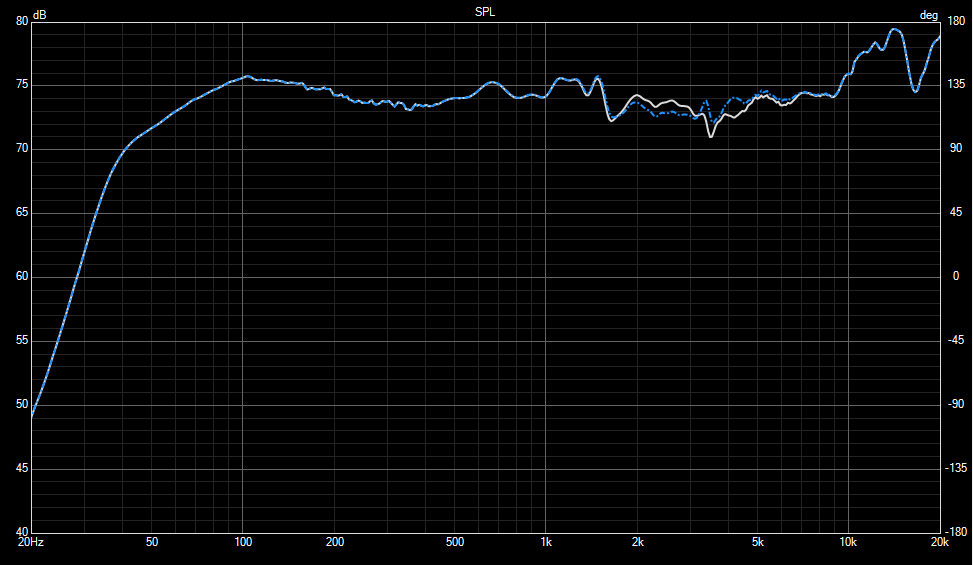
And the simple schematic.
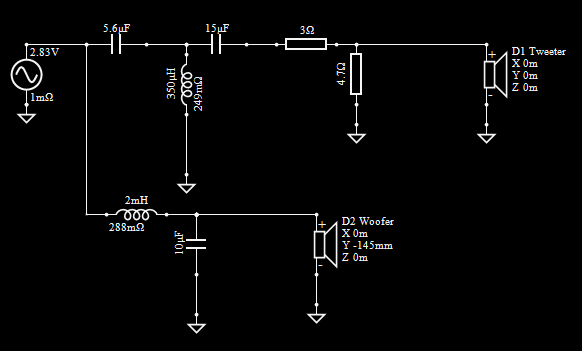
Thanks for posting this info.
Is it me ? but it looks like you ended up with steeper roll-offs than what I'd guess for a 2nd / 3rd order filter Xover combo. And/or you hit the Xover point just about right for these drivers.
If you don't mind, for my learning info, going from an initial run of component values (out of the software box) could you walk me though your thought process and which components did you adjust, and effects.
My take on the crossover deal now knowing a bit about it was mirrored by what Ben just mentioned. I was pretty much focused on the opera singer track as the main influence on judgment. When I initially heard #2 I was intrigued and voted for it. Then as the next few played I kinda questioned what I noticed in that track till #7 played. It also struck me as special, with #9 kinda there too. Overall I picked 2 after hearing the top three played. If what you said about #2s response is true, this mimicks how I normally voice my speakers, which is BBC dip and a bit brighter up top.
That being said, that was a fun experiment, but needed a few changes to make things flow better. Me personally, fewer tracks with fuller compositions and mandatory connections and labeling. I think an A or B bracket would have been easier to discern differences and you guys could have just stood there to swap xovers having a shorter test track.
Otherwise I still thought it was fun. A lot of them sounded fine, but goes to show small idiosyncrasies can make a difference. Thanks for putting that together guys!
Yes, it was very fun and I do feel I learned a lot. At the very least it was a good exercise.
I was concerned that mine would appear "amateur" in comparison to many of the other very talented designers. I think it faired well and what I heard from the back of the room seemed to match my expectations. Matt Sobie did help a bit, in the end what we came up with after our phone conversation matched values and topologies I had already siimulated, just different configuration.
A lot of the designs that I thought sounded good had some form of BBC dip. If everyone shared simulations I might try a few and see what sounds best in my room.
I was surprised to hear a few people picked their own designs. Curious if they had something that was an audible signature? This seems to prove that there is no "perfect" crossover, just a preference of compromises.
Filter order of passive filters doesn't often align perfectly with textbook slope, unless the load is purely resistive and the component selection is for a textbook response, which it isn't for most speakers.
With that in mind, if you look at the tweeter filter, I have -34dB at 1kHz, and -15.8dB at 2kHz making for 18.2dB/oct slope, aligns well with a 3rd order filter. However, the overall filter shape and knee is quite far from a textbook filter. Acoustic response aligns with a 4th order slope.
Looking at the woofer filter, I have -10.5dB at 2500Hz, and -24.5dB at 5000Hz making for 14dB/oct slope, relatively close to 12dB textbook target. Again, the overall filter shape and knee is miles from a textbook filter. Acoustic response aligns with a 4th order slope but only at high frequency as the shelf in the response throws it for a loop.
It's like I mentioned above, I aimed for as simple as possible design that I would say is "good enough", with focus on overall in-room response. A true in-room and power response would require full 360 degree of response data, but we'll glance over that.
The biggest hurdle I had in achieving this goal is the 5dB shelf in the woofer response which in my opinion sort of forces your hand on crossover point for a low complexity design. Any attempt to notch the woofer breakup I found was detrimental to overall in-room / power response, and any change in crossover frequency made for a rather wonky response, so I just aimed for overall balance keeping it as simple as possible. You can see it mirrored through all the charts above, the directivity mismatch between these drivers, so in order to achieve a constant slope for in-room response, the on-axis response of the woofer is raised a bit 500-1500Hz, and the tweeter response has a bit of a trough from 2-4kHz.
Here's my design Ken.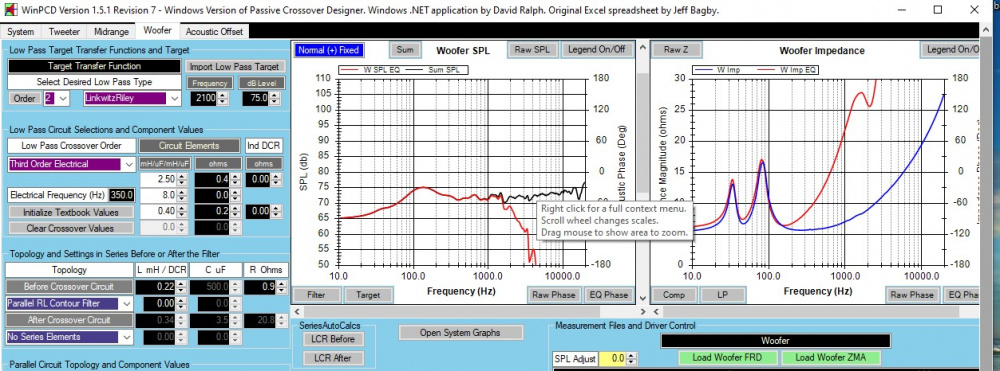
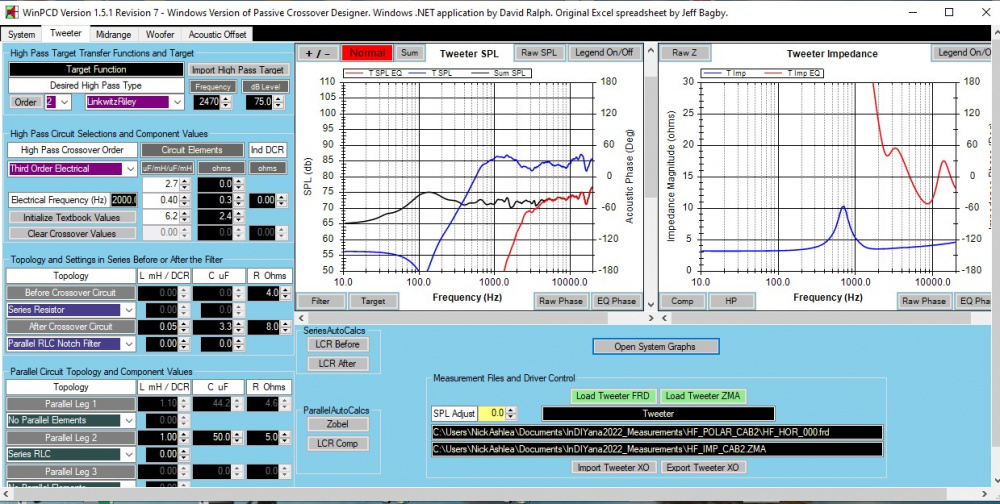
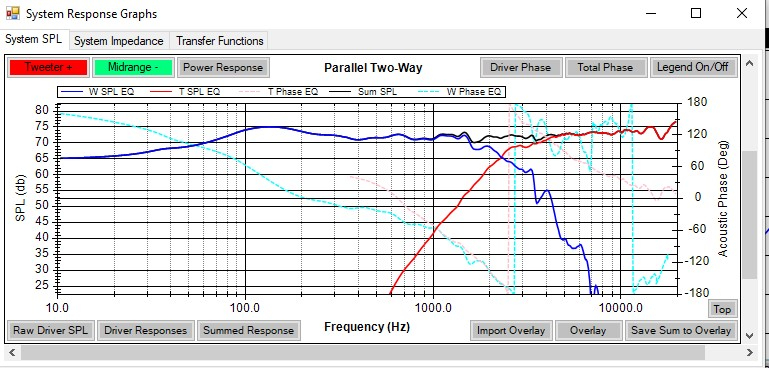
Well, simulations aside - prior to the start of the theme, I predicted that a design using less baffle step would win. EQ's design utilized less than 3db so it was somewhat louder than the rest, and with his inclusion of a dip right in the area where his 4th LR crossover was blooming off-axis to counter excess energy in the horizontal I would have been surprised if it hadn't won.
That being said, all designs presented fairly similar from my position in the back of the room. The biggest differences were largely in the Cecelia Bartolie track and the John Prine track, and of course the low bass in the metal track at the end was pretty much all lost. At our listening level, the little woofers were probably just a few db from running the risk of jumping the gap. They were borderline compressing mechanically as it was.
Bartolie and Prine were both fairly revealing of the woofer breakup and higher crossover points, as well as the tweeter impedance peak.
Some of the depth of the first track was likely lost on those not seated dead-center. Otherwise, it is a fun track to try and pick out the various passages.
The McLaughlin and Prine tracks were both prone to being sibilant heavy.
The string quartet was a Mozart piece, and it was included because we needed strings. I thought this was a good, clean example of just such a thing. Similar to the three guitar track it is fun to try and pick out the moment when the striking tool hits the string. The pick and the bow, as it were. (That would be a cool name for a bar).
Larry Coryell & Badi Assad & John Abercrombie - Seu Jorge E Dona Ica - Three Guitars
Cecilia Bartolie - VivaldiS posa son disprezzata -: Sopranos Peppers & Eggs (Disc 2)
Sarah McLachlan - Angel - City Of Angels
Mozart - String Quartet No. 17 in B-flat major, K. 458, "Hunt": Minuetto - The Very Best of Mozart (I do not know the conductor or specific quartet who performed it)
John Prine - Day is Done - Lost Dogs and Mixed Blessings (buy this album)
Powertrip - Manifest Decimation - Manifest Decimation
All six tracks were chosen to be a blend of the typical stuff we hear at these things as well as a few things we often forget are also a straight-up challenge to even the best speakers. The Powertrip track in particular really shines on a speaker that plays very deep and is capable of holding things together at the same time. 2-ways generally fare pretty poorly well-recorded metal at most listening levels and are pretty much inadequate if you want to tickle the neighbors fancy. John Prine is deceptively hard to render correctly as well, despite being little more than a middle aged man and his guitar.
Anyways, the missus and I had a great time even if I have spent most of the weekend feeling pretty green. No idea what got into me, but hopefully I feel back to normal pretty soon.
Mrs. JR sends her regards!
Shazam says the Mozart is by the Eder Quartet.
https://amazon.com/Mozart-Quartets-Wolfgang-Composer-1993-12-31/dp/B014I3FD3I
Ron
If you want to give mine a go, minor details but I would make the following changes given the 20mm discrepancy in the woofer data.
Ben, thanks for another fun time and theme challenge. I have hope since the top 2 of 3 were voiced. I think if the room was more neutral we could have heard more distinctions. The opera track was awesome along with the bass track at the end. I don't think we can ever have another DIY event without an opera track.
I'm not sure where the time went. We didn't have that many speakers and quite a few did not get to play on Saturday.
My apologies to Bill S for not making the tents this year.
We usually get a heads up on the theme for next year so we can buy drivers and MWAF, so ???
John-
I haven't even thought hard about it, but have ideas. I usually announce it by the MWAF event.
For those that wanted to see mine:
The LC was added after the FR sim, and the impedance was inaccurate as I removed the input compensation so I removed that portion of the image. The tweeter response should be close except around Fs.
Once I get the images on disc from Bill, I will upload network photos.
Ken-
The connections were SUPPOSED to be standardized. It was listed on the event website, and discussed at length in both MAC and PE forums. Jacks and leads on the same end of the board. I'm glad I had the foam in place or some of them would have been viewable being out of the bag for the demo. A couple had inputs on the opposing end. One had inputs on the opposing face from the components. One came loose from the input jack. One had crossed wires that needed spread out to fix a problem. Several had no markings to which was tweeter and which was woofer; I'm glad Nick and I know typical filter design or we would not have been able to get that connected right- and even still I had one flipped over the course of the demo. Simply- there was no complete consensus and acceptance of the layout as about half were not following it. Don't get me wrong, as I'm not complaining. We got through it just fine. It was just more difficult than it had to be.
EQ tried to get banana plugs/jacks shipped to him, but the process failed. That was the one I could not quickly resolve for connection, but only he/Nick/myself knew that was his set of boards due to the collars being tightened on the posts.
InDIYana Event Website
Here is my theme entry crossover. AKA #6
I used a notch filter at 900 hertz to attenuate a peak, possibly from enclosure diffraction. I went 2-3 decibels extra to make sure it was gone.
I used a 500 uF high pass on the woofer in an attempt to reduce low frequency excursion and hopefully improve the midrange with reduced Doppler distortion.
The tweeter had a single cap for both high pass and attenuation. The top end of the woofer was unfiltered.
Here is the electrical transfer function.
Here is the simulated frequency response, power response, and impedance. Notice how smooth the power response looks!
I couldn't detect which was mine during the theme event. Later, when everyone was packing up to leave, I gave it a listen. It sounded good overall but a bit flat and unexciting, most likely caused by the high crossover frequency. I was hoping for uninterrupted phase response in the midrange, I'm not sure that was a good decision. This is how we learn though.
I went full NTM style
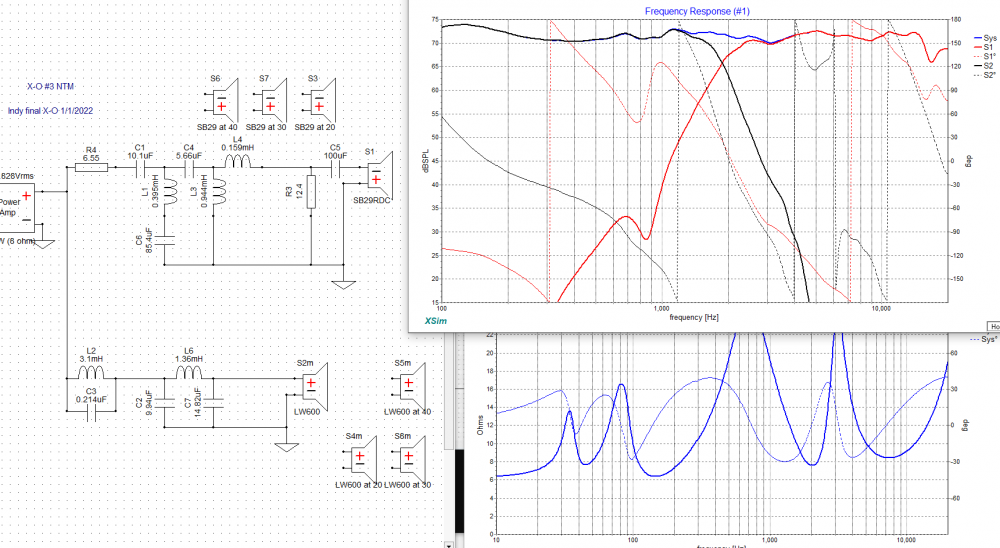
Mrs. JR and I are through security and waiting to board. Be home for lunch and a nap, then mow the lawn and (ugh) back to work tomorrow.
-

Looks like the tweeter played to the dip nicely. I can see how that could work for a OE trying to sell speakers. Where I was in the back they did sound smooth and laid back. I did not perceive the high end rise, this could have been my location as well.
Thanks for sharing.
Congrats to Ben & Chuck on the award!! Well deserved!
Congrats to E.Q. from Singapore, winner of the missing link xover design competition (entry #2). He completed his xover in the adjoining room just moments before the competition began. Special mention goes to Meredith C., as some of the parts from his 4 way OB speaker project were used by E.Q. to complete the winning xovers.
Thanks, guys! I was really shocked, and it took about 45 minutes before I was myself again.
InDIYana Event Website
I wish I had been feeling a little less green all weekend - I would have liked to spend a little more time with each of you.
Thanks @kenrhodes for putting my crossover together and delivering to the event. It was nice to be able to be a part of one of these things even from 2000 miles away.
I totally missed the award, when did that happen?
It was after the xover competition had ended and after we got back from lunch. So you must have had a long lunch. According to the time stamps on my photos, it occured from 1:26pm to 1:27pm CT (2:26 to 2:27pm ET).
John, What was the bag number on your xover? I am entering all the xovers into VituixCad's variant buttons so that I can quickly compare 8 crossover simulations against my listening notes. My xover was bag #4. Here is my VituixCad 6 pack screen:
When I was talking to John afterwards, he said that some of the entries sounded dull from his seat, while in the back I didn't find any dull, and actually found a fair number too forward. While walking forward to change the entries I could hear that some of the designs had off axis issues around the crossover frequency. I also noticed that the woofer breakup was not controlled on all of the entries.
If you want to experiment/learn I would suggest that you try them all, so that you can correlate the sound to measured response in a familiar room and system, but if I was going to design a similar system from scratch, I would use the Dynavox poly cone woofer. In my opinion, it's a better, smoother, easier to use driver.
Nick, What was the bag number for your xover? I am inputing all xovers as variants into my VituixCad model so that I can compare all xovers to my listening notes.
I was 5 Bill.
I was bag #3. No one had the woofer break up pushed further down. Though there was some off axis mid range bloom.
I hogged the sweet spot, though there was no toe in as originally discussed, so slightly off axis.
Bill, I know you said you were doing that for your notes but will you post a summary here? Either the VituixCAD 6 pack for each and/or overlays of the SPL curves?
With Ben's permission, I could definitely do that. I don't know what Ben's plan is regarding posting the schematics or bag numbers. So far, I only have schematics for 6 of the 11 bag numbers. Still need schematics for bags 2, 8, 9, 10, and 11.